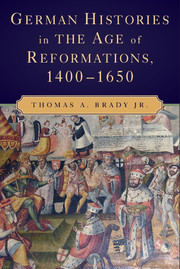Book contents
- Frontmatter
- Contents
- Figures, Maps, and Tables
- Acknowledgments
- A Note on Usages
- Map 1 The Empire in 1547
- Map 2 The Peace of Westphalia, 1648
- Part I The Empire, the German Lands, and Their Peoples
- Part II Reform of the Empire and the Church, 1400–1520
- 5 Reform of Empire and Church
- 6 The Empire and the Territorial States
- 7 The Reform of the Empire in the Age of Maximilian I
- 8 Ideals and Illusions of Reforming the Church
- Part III Church, Reformations, and Empire, 1520–1576
- Part IV Confessions, Empire, and War, 1576–1650
- Appendix
- Glossary
- Bibliography
- Index
5 - Reform of Empire and Church
Published online by Cambridge University Press: 05 June 2012
- Frontmatter
- Contents
- Figures, Maps, and Tables
- Acknowledgments
- A Note on Usages
- Map 1 The Empire in 1547
- Map 2 The Peace of Westphalia, 1648
- Part I The Empire, the German Lands, and Their Peoples
- Part II Reform of the Empire and the Church, 1400–1520
- 5 Reform of Empire and Church
- 6 The Empire and the Territorial States
- 7 The Reform of the Empire in the Age of Maximilian I
- 8 Ideals and Illusions of Reforming the Church
- Part III Church, Reformations, and Empire, 1520–1576
- Part IV Confessions, Empire, and War, 1576–1650
- Appendix
- Glossary
- Bibliography
- Index
Summary
The emperor is one ruler of the world exercising his authority over the others in the plenitude of power, and in his own sphere he is the equal of the Roman pontiff in the temporal hierarchy on the model of the sacerdotal hierarchy.
Nicholas of CusaOn Christmas Day 1414 at two o'clock in the morning, King Sigismund (b. 1368, r. 1410–37) and Queen Barbara (ca. 1390–1451) of Cilli/Celje arrived by boat at the docks of Constance, a middling free city at the western end of Lake Constance. They had come to open a general council of the Church, called to end the festering Western Schism, and to undertake a reform of the Church, as the common phrase ran, “in head and in members.” The undertaking had begun, records the Constance burgher Ulrich von Richental (d. ca. 1438), when “our lord King Sigismund sent word to Our Holy Father, Pope John XXIII, that he should fulfill his promise to give peace and rest to Holy Christendom.” The king had further announced that the council “should not be delayed, [so that] the princes spiritual and temporal would take notice that Holy Christendom will suffer great harm, and the holy ship of St. Peter will founder in such weather.” As churchmen streamed in from the four corners of Christendom, “everyone looked for the arrival of our lord King and the electors, and no session was held, and no man would take part in one” until the king should arrive.
- Type
- Chapter
- Information
- German Histories in the Age of Reformations, 1400–1650 , pp. 71 - 88Publisher: Cambridge University PressPrint publication year: 2009



